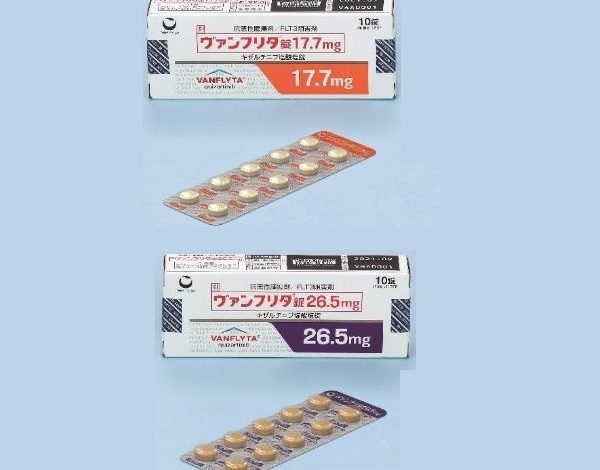Vanflyta: Uses, Benefits, Dosage, Side Effects, Interactions

What is Vanflyta?
Vanflyta, also known by its generic name quizartinib, is an oral kinase inhibitor primarily used to treat adults with newly diagnosed acute myeloid leukemia (AML) that is FLT3-ITD positive. AML is a type of cancer that affects the blood and bone marrow. FLT3 mutations, especially FLT3-ITD, are commonly found in AML patients, and these mutations are associated with a poor prognosis, increased risk of relapse, and shorter overall survival.
The mechanism of action of Vanflyta is centered around its potent inhibition of FLT3, a receptor tyrosine kinase. By blocking FLT3 signaling, the drug can impede FLT3-ITD-dependent cell proliferation, slowing down the progression of AML and potentially improving overall survival.
It is important to note that Vanflyta is specifically developed by the Japanese pharmaceutical company Daiichi Sankyo for patients with FLT3-ITD-positive AML. Before starting the treatment, a test will be conducted to confirm the presence of this mutation and to ensure that Vanflyta is the appropriate medication for the patient.
Vanflyta Benefits
Vanflyta (quizartinib) offers several significant benefits for patients with Positive Acute Myeloid Leukemia (AML). Some of the key benefits include:
1. Targeted Therapy: Vanflyta is a targeted therapy specifically designed to inhibit the FLT3-ITD mutation, which is commonly found in patients with Positive AML. By targeting this specific mutation, Vanflyta aims to disrupt the growth and survival of leukemia cells, potentially leading to improved treatment outcomes.
2. Improved Response Rates: Clinical trials have shown that Vanflyta can induce high rates of complete remission and partial remission in patients with Positive AML. Achieving remission is a critical goal in AML treatment as it indicates the reduction or elimination of leukemia cells in the bone marrow.
3. Prolonged Survival: Vanflyta has demonstrated the potential to extend overall survival in patients with Positive AML when compared to standard chemotherapy alone. This extension of survival is a significant advancement in the treatment of this aggressive form of leukemia.
4. Reduced Toxicity: Unlike traditional chemotherapy, which often affects both healthy and cancerous cells, targeted therapies like Vanflyta tend to have a more focused impact on cancer cells. This targeted approach may result in reduced toxicity and fewer adverse effects for patients.
5. Potential for Combination Therapy: Vanflyta can be used in combination with other therapies to further enhance its efficacy. Combining Vanflyta with other agents may lead to synergistic effects, making it a valuable addition to treatment regimens for Positive AML patients.
6. Convenience: Vanflyta is available in oral form, which offers convenience for patients compared to intravenous chemotherapy. This may lead to improved adherence to treatment and overall quality of life.
7. Access through Risk Evaluation and Mitigation Strategy (REMS): Although Vanflyta has certain serious side effects, its availability through a restricted program called the Vanflyta Risk Evaluation and Mitigation Strategy (REMS) ensures that patients receive proper monitoring and education about potential risks, allowing for early detection and management of adverse events.
Overall, Vanflyta represents a significant advancement in the treatment landscape for patients with Positive AML. Its targeted approach, improved response rates, prolonged survival, and potential for combination therapy make it a promising option for those affected by this challenging form of leukemia. As with any treatment, patients should discuss the potential benefits and risks with their healthcare provider to make informed decisions about their care.
Dosage and Administration
Vanflyta is taken orally once a day at approximately the same time each day. It can be taken with or without food, but the tablets must be swallowed whole without cutting, crushing, or chewing. Patients should follow their healthcare provider’s instructions regarding the dosage and should not alter the dose or discontinue treatment without medical guidance.
Missed Dose and Overdose
If a dose is missed, it should be taken as soon as possible on the same day, and the next dose should be taken at the usual time on the following day. Double dosing to make up for a missed dose should be avoided. In case of overdose, emergency medical attention should be sought immediately.
Pregnancy and Breastfeeding
Vanflyta can be harmful to unborn babies, and females who can become pregnant must take a pregnancy test before starting treatment. It is essential to use effective contraception during treatment and for a specific duration after the last dose. Breastfeeding should be avoided during treatment and for a month after the last dose.
Vanflyta Side Effects
Vanflyta can cause serious side effects, including:
• Changes in the electrical activity of the heart (QT prolongation, torsades de pointes, irregular heartbeats) that can be life-threatening or fatal.
• Regular monitoring of heart activity through electrocardiograms (ECGs) and blood tests for potassium and magnesium levels is essential during treatment.
• Seek immediate medical attention if you experience an irregular heartbeat, dizziness, lightheadedness, fainting, diarrhea, or vomiting.
Common Side Effects:
• Low white blood cell counts.
• Changes in blood electrolyte levels.
• Abnormal liver function test results.
• Low white blood cell counts with fever.
• Diarrhea.
• Mouth sores.
• Nausea.
• Abdominal pain.
• Serious infections, including sepsis affecting organs.
• Headache.
• Vomiting.
• Upper respiratory tract infections.
• Low platelet counts.
• Decreased appetite.
• Fungal infections.
• Nosebleeds.
• Herpesvirus infections.
• Trouble sleeping.
• Abnormal electrocardiogram (QT prolongation).
• Upset stomach.
• Low red blood cell counts (anemia).
• Eye irritation.
Please note that the above list does not cover all possible side effects of Vanflyta. Contact your doctor for medical advice on side effects, and report any adverse reactions to the FDA at 1-800-FDA-1088.
Vanflyta Risk Evaluation and Mitigation Strategy (REMS):
• Due to the risk of QT prolongation, torsades de pointes, and cardiac arrest, Vanflyta is available only through a restricted program called the Vanflyta Risk Evaluation and Mitigation Strategy (REMS).
• Patients will receive a Patient Wallet Card from their healthcare provider and should carry it at all times and show it to any healthcare providers.
• Seek immediate medical help if you develop any signs or symptoms of QT prolongation and torsades de pointes listed on the card, as hospital treatment may be necessary.
Drug Interactions with Vanflyta
It is crucial for patients to provide their healthcare provider with a comprehensive list of all medications they are currently taking, including prescription drugs, over-the-counter medications, vitamins, and herbal supplements. Certain drugs may interact with Vanflyta, potentially leading to adverse effects or reduced efficacy. To ensure patient safety and the effectiveness of treatment, healthcare providers need to be aware of any potential drug interactions.
1. QT Interval Prolonging Drugs: Vanflyta has the potential to cause changes in the electrical activity of the heart, leading to QT interval prolongation, torsades de pointes, and irregular heartbeats. Therefore, it is essential to avoid co-administration of Vanflyta with other medications known to prolong the QT interval. Combining Vanflyta with such drugs can increase the risk of severe cardiac events. If the use of QT interval prolonging drugs is medically necessary, the healthcare provider may need to adjust the Vanflyta dosage or closely monitor the patient’s heart function.
2. Strong CYP3A Inhibitors: Vanflyta is primarily metabolized by the cytochrome P450 enzyme CYP3A. Drugs that inhibit CYP3A activity can lead to increased Vanflyta levels in the bloodstream, potentially causing toxic effects. Therefore, the concomitant use of strong CYP3A inhibitors should be avoided or managed carefully by adjusting the Vanflyta dose to prevent toxicity.
3. Strong CYP3A Inducers: On the other hand, strong CYP3A inducers can decrease Vanflyta levels in the blood, reducing its effectiveness in treating acute myeloid leukemia. Patients receiving strong CYP3A inducers should be closely monitored, and dosage adjustments may be necessary to ensure adequate therapeutic levels of Vanflyta.
4. Other Medications and Supplements: Aside from the specific interactions mentioned above, there may be other drugs or supplements that can interact with Vanflyta. Certain medications or supplements might affect the metabolism or elimination of Vanflyta, leading to altered drug levels in the body. It is vital for patients to disclose all medications and supplements to their healthcare provider to identify any potential interactions.
To minimize the risk of drug interactions, patients should always follow their healthcare provider’s recommendations and inform them promptly if they experience any unusual side effects or changes in their health while taking Vanflyta. This open communication will allow the healthcare team to take appropriate action, such as adjusting dosages, changing medications, or closely monitoring the patient’s condition to ensure safe and effective treatment.
Storage
Vanflyta should be stored at room temperature, between 68°F and 77°F (20°C and 25°C), and kept out of the reach of children.
Patients considering or prescribed Vanflyta should have a thorough discussion with their healthcare provider to understand its risks, benefits, and proper use for the treatment of their condition. Additionally, they should be vigilant about potential side effects and follow the recommended guidelines for taking the medication to ensure optimal therapeutic outcomes.





